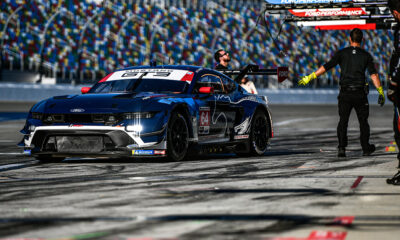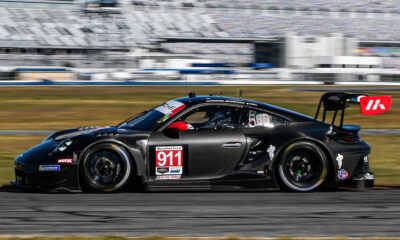
Photo: Jake Galstad/IMSA
IMSA President John Doonan says he’s more focused on the quality of the grid of this weekend’s Rolex 24 at Daytona rather than the total number of entries, in the wake of a record-low field for the Florida endurance classic.
A total of 38 cars are set to take part in the 58th annual running of the twice-around-the-clock enduro, down from the 47-car grid from last year and previous record low of 44 in 2003 and 2010.
While featuring a slightly increased field of LMP2 entries, car counts in DPi, GT Le Mans and GT Daytona are all down from last year, including the absence of Chip Ganassi Racing for the first time in 16 years.
The pair of CGR-run Ford GTs, along with CORE autosport’s Nissan DPi and two fewer Cadillac DPi-V.Rs, has all led to the depletion of the top categories.
Despite featuring one additional manufacturer in Aston Martin, the GTD class has seen a drop of five cars compared to 2019, including the absence of longtime Rolex 24 entrants AF Corse and Montaplast by Land Motorsport.
When asked by Sportscar365 on whether he’s concerned over the car count, Doonan suggested that the quality of the driver lineups could arguably be at an all-time high.
“It’s always IMSA’s goal to put as many cars on the track as we can,” he said. “But when you talk the quality of the field versus sheer numbers…
“Yeah there’s lots of stats that may tell us that this is the lowest entry count in x number of years but I’m more focused on the quality.
“Everybody knew the Ford GT program was coming to a close. Everybody knows that it isn’t easy to put a program on track. It takes a lot of resources.
“Rather than talking about those that are not here, I think the primary focus is talking about who is here.
“The quality of the driver lineup is perhaps maybe at an all-time high.
“The number of drivers crossing over from IndyCar, NASCAR, from global championships, former winners… There’s a lot of Rolex’s in the garage.
“Then you can talk about an LMP2 field that you could barely have a podium with a year ago nearly doubled (ed: prior to RWR and second PR1/Mathiasen withdrawal). You talk about GTD and the number of teams and manufacturers there.
“Obviously the Corvette C8.R and the new Porsche are amazing new entries.
“We’ve got a very solid field of quality entries.”
The DPi class, which was split from LMP2s for 2019, has gone from 11 to eight cars for this year, with Action Express Racing dropping back to a single-car program for the first time in the team’s history, along with CORE and Juncos Racing not returning.
While admitting that the next two years could be considered “transitional” years for DPi, prior to the launch of new regulations in 2022, Doonan believes there’s still a chance for new content to arrive later this year.
It’s known an active effort is underway from Dyson Racing and Spirit of Daytona Racing to field a customer Mazda RT24-P, potentially for a mid-season debut.
“My hope is that even though we may see regulations and have them defined soon, that people might come in,” Doonan said.
“I’ve had several folks that are looking at it say, ‘Boy, it would be neat to come in and learn the IMSA system.’ So you may see some of those.
“The goal is to focus on our current investors and hope others join.”
Doonan, who transitioned from his role as Mazda Motorsports director to IMSA’s President late last year, said one of his biggest goals for his first year in office is to better understand teams’ needs.
“One of my sincere interests in trying to use my previous life and my new role is talking with the team owners,” he said.
“It’s not cheap. The cars aren’t cheap and the cost to compete isn’t cheap.
“We have to continue to work with them and understand the areas that are challenges for them and see if IMSA themselves can have an impact on that.”

























